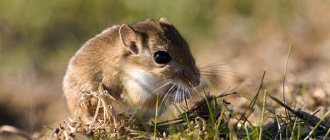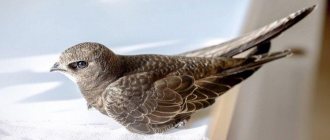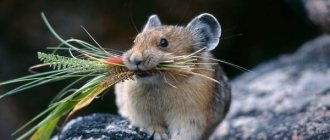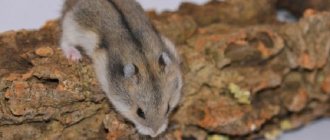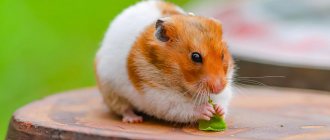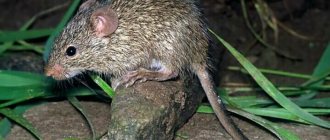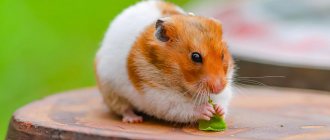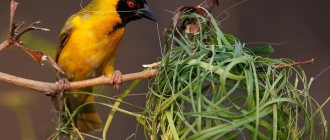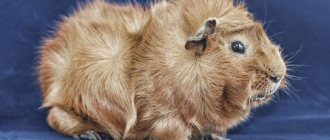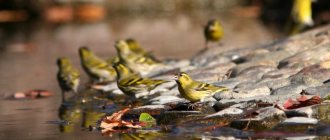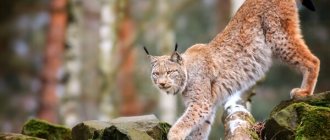- Wild animals
- >>
- Mammals
Gerbils are a large subfamily from the Old World. Its members are among the most distinct in the large rodent superfamily Muroidea, which includes mice, rats, voles, hamsters, gerbils and many other relatives. Members of the gerbil subfamily (Gerbillinae) have much in common. Most of them are diurnal, desert rodents. Gerbils are funny rodents that live in the wild and adapt well to home conditions. How and where gerbils live, everything about their methods of reproduction and other facts about their existence can be learned from this material.
Origin of the species and description
Photo: Gerbil
There are up to 110 species of gerbils in 16 existing genera. They belong to the mouse-like family and form a common branch with mice with long tails. They can be separated morphologically from other mouse-like species by a number of derived features. Molecular genetic studies of several mitochondrial and nuclear DNA genes confirm their independent origin and show that they are more closely related to mice and are the sister group of Deominaceae.
Video: Gerbil
In earlier classifications, Old World gerbils were often classified as the closest relatives of the Hamster or Madagascar rats and other endemic African mice. The close connection with the ancient mouse-like animals, which have a more complex type of molar tooth, was due to the great similarity in the pattern of molar crowns in gerbils and in them. However, most ancient mouse fossils have additional cusps of lower jaw teeth that were originally unknown in gerbils.
Modern gerbils have large eyes and good vision. They use auditory, chemical and tactile signals to perceive their environment. Rodents also exchange chemicals with each other, using pheromones to indicate reproductive and social status. Male gerbils communicate territorial ownership by marking territory with scent from their large ventral sebaceous glands. Gerbils do not live longer than three or four months in the wild. It is known that in captivity some individuals managed to live up to eight years.
Behavior at home
Most species of gerbils sleep at night and are active during the day. But not all of them, so you can buy an animal that will not give you rest at night. Check with the seller what time of day rodents sleep.
It’s not for nothing that we mentioned activity - gerbils do not sit still. They are always in motion: you are unlikely to be able to hold them in your arms and stroke them for more than a few seconds (unless, of course, you force your pet, but this cannot be done).
However, gerbils have a very friendly nature. They get used to the owner and his voice. They can be litter trained and played with.
The animal treats people well.
We train to the toilet in several stages (select only one individual and train it immediately).
- When the gerbil has gone the wrong way, we take the balls of excrement and put them in the tray. We look at the reaction: if the toilet still does not attract rodents, move on to the next step.
- We keep an eye on the rodents, and as soon as we see that the pet has sat down to “go big,” we carefully pick it up and carry it to the tray. This requires patience and it won’t take you to get the hang of it right away, but it works. And it’s easier to care for the animals later - the time spent is worth it.
- If you manage to train one pet to use the toilet, the rest usually begin to repeat its actions. But if individual individuals “fundamentally” do not want to live in a “civilized” manner, repeat the steps for them separately.
Another important point: gerbils in nature live in large colony families, so they feel much better in company. The owner cannot replace their relatives, even if they devote a lot of time to caring for the pet and playing.
Animals should be together since childhood. If you later try to add a third animal to an already living couple (in a month, for example), they will not accept it.
A little about the relationship between gerbils. Sometimes they may struggle a little, but that's okay. But if the fight leads to blood, then immediately seat your pets. Not for long, for a few hours (you can’t separate for a long time, so as not to forget each other’s smell).
Now a little about the negative aspects of keeping gerbils.
They chew all the time. They chew everything they come across, so make sure that it is not your furniture (more on that below). When gerbils are not gnawing, they are digging; therefore, dirt is guaranteed (but this is not a problem if you choose the right house: we will tell you how to make cleaning easier).
Males also mark territory. Of course, the “amber” is not like the March cat, but keep this in mind. Females can too, but this is less common. There is no need to worry about this: gerbils have very little odor (less than, for example, hamsters).
Appearance and features
Photo: What a gerbil looks like
Gerbils are small to medium-sized rodents. Their length ranges from 50 to 200 mm, and their tails range from 56 to 245 mm. The weight of individuals is from 10 to 227 grams. Even within a species, males may be heavier than females in one population and may be the same size in another population. These are usually slender animals with long claws. They may have long or short ears. Most gerbils have long, well-furred coats and long, narrow hind legs.
The fur color varies over a wide range of colors and can be reddish, grey, yellowish, clayey, olive, dark brown, orange-brown, sandy yellow or pinkish-cinnamon on the dorsal surface. The underparts are usually lighter shades of grey, cream or white. Some species have whitish spots on the head, especially behind the ears.
Gerbils have a dental formula of 1/1, 0/0, 0/0, 3/3 = 16, with the exception of the genus Desmodilliscus, which has only two lower molars on each side. The layers of enamel on the incisors are very thin compared to other rodents. Gerbils have 12 thoracic and seven lumbar vertebrae. Females have three or four pairs of mammary glands. The stomach consists of only one chamber. Gerbils are related to mice and rats and belong to the family Muridae.
Pet diseases
Gerbils tend to be in good health compared to other rodents, but it doesn't hurt to be aware of common diseases and their symptoms. Do not self-medicate - immediately contact a veterinarian (a rodent specialist is called a ratologist).
- If the eyes are watery and purulent, then it is most likely conjunctivitis. Protect the animal from dust, hide it in a house out of direct rays of light, and as soon as possible, take it to the clinic.
- Nasal discharge may indicate an allergy. Just in case, immediately change the type of bedding, think about what in the diet could give such an effect. If there is no change in a couple of days, call your veterinarian.
- If the belly suddenly begins to increase in size and does not go away, all this is accompanied by diarrhea (i.e. it is not bloating), then this may be Tyzzer's disease (fluid accumulates in the abdominal cavity). The reason is missing food. Most often, there is nothing you can do to help here, so make sure the food is fresh and the house is clean.
Gerbils also suffer from epilepsy and cancer, but in these cases little depends on us.
Regarding vaccination. There are no special medications for gerbils. But if your pet does not come into contact with other people’s rodents, then there is nothing to be afraid of.
Where does the gerbil live?
Photo: Gerbil in Russia
Gerbils are Old World rodents. They are distributed throughout Africa and the Middle East, through Central Asia including most of India, China (excluding the southern and eastern regions) and eastern Mongolia. Their range extends from several islands in the eastern Mediterranean and northeastern Ciscaucasia to Transbaikalia and Kazakhstan.
The gerbil's range is concentrated in three main regions:
- in the savannas of Africa, as well as in the Namib and Kalahari, where winter temperatures often drop below zero;
- in hot deserts and semi-deserts of Africa and the Middle East, as well as in the dry Horn of Africa;
- in the deserts, semi-deserts and steppes of Asia, where winter temperatures also drop significantly below zero.
Individual genera usually belong to one of these three regions. Most gerbils live in dry, open habitats with sparse vegetation, including deserts, sand plains, mountain slopes, grasslands, steppes and savannas. Some species also live in moist forests, agricultural fields and mountain valleys.
Water is usually excreted through the skin, breath, urine and feces. Most gerbils live in arid regions with difficult climatic conditions and have a body surface that is unfavorably large in relation to volume. They have developed tailored properties to minimize water loss and thereby reduce fluid requirements. They do not sweat and therefore cannot withstand temperatures above 45 °C for more than two hours.
Now you know where the gerbil lives. Let's see what she eats.
Choosing a pet
You have bought everything you need for care, allocated a place for your new pet, and now it’s time to move on to the most important thing - choosing the animal itself. First, let's take a look at the breeds
There are already more than 110 species of gerbils; we will focus on the most popular.
Gerbil breeds
Mongolian, also known as clawed. The most common inhabitant of houses and apartments. The color of the coat is from coal black to snowy white - the breeders took care of diversity. There are even bluish shades. It grows up to 20 cm in length, weighs about 120 g. There is often a small tassel at the end of the tail.
Color options for the “Mongols” can be seen in the video below. But please ignore the advice that it is better to feed the rodent more often with sweets and tropical fruits.
Fluffy-tailed. This species is captivating with its chic tassel on the tail. In stores you usually only find the sand color. Length 10-13 cm.
Fluffy-tailed. This is a tail you can be proud of!
Short-eared. Red or brownish, white belly. Grows up to 12 cm.
Short-eared, but very cute.
Cheeseman's gerbil grows up to 11 cm, with a long tail. The most interesting feature is the huge (relative to the head) eyes.
You can drown in such eyes... Cheeseman's gerbil.
Persian. Quite a large individual (can grow up to 20 cm and gain weight of 170 g). Has a beautiful tassel at the end of the tail.
Persian beauty.
Let's go buy
Where to buy animals - from breeders or in a store - is everyone’s personal choice. We do not agree with the opinion that stores provide poor care and often sneak in already sick animals. Choose a store that is trusted (fortunately, reviews can be found on the Internet without any problems). In a good store and good care. At the same time, we met with private breeders who kept their pets in terrible conditions and tried to sell old gerbils or the wrong sex
Therefore, it doesn’t matter where to buy, but make preliminary inquiries about the seller
Below are the main points to pay attention to when purchasing
- If you are going to take pets of different sexes, it is advisable that they be from different parents (to reduce the risk of genetic diseases).
- It is better to take same-sex dogs from the same litter so that they are already accustomed to each other.
- It's great if you can look at your parents. It will be immediately obvious whether they are active or lethargic, friendly or aggressive. Offspring are likely to inherit character traits.
- The best age to buy is 6-9 weeks. If you have no experience, it is difficult to determine age. Bring experienced gerbil keepers with you if possible. If not, rely on reliable sellers.
- Eyes, ears, nose should be free of discharge and inflammation.
- The coat should be smooth, clean and not matted anywhere (feel free to look under the tail).
- There should be no scratches, wounds or rashes on the skin.
- Listen to your breathing, usually if there is wheezing, you can hear it.
- A healthy gerbil is active and inquisitive, but if the animal is lethargic and does not respond to you, then it may be sick.
We are already waiting for new owners :)
Determining gender
Determining sex at such an early age (6-9 weeks, as we recommend for purchase) is difficult, but there are still signs.
If the age is closer to the upper limit, then in males, when you lightly press on the belly, the testes (testicles) protrude. By the way, this is one of the ways to check age, because... They will not perform for very young boys.
Another way. The distance between the anus and the genitals in females is much smaller, literally millimeters. Males have much more.
What does a gerbil eat?
Photo: Gerbil mouse
Gerbils primarily feed on plant material such as seeds, fruits, leaves, stems, roots and tubers. Nocturnal species of true gerbils search for wind-blown seeds in the desert. The Indian gerbil is the only species that needs fresh food all year round, so it often lives near irrigated fields. However, most species take what they can get and also eat insects, snails, reptiles and even other rodents. In particular, animals in the extremely dry deserts of southern Africa primarily catch insects, and the Wagner's gerbil (G. dasyurus) produces mountains of empty snail shells.
The gerbil's favorite treats include:
- nuts;
- seeds;
- roots;
- bulbs;
- fruit;
- herbs;
- insects;
- bird eggs;
- chicks
- reptiles;
- other rodents.
The food is usually eaten immediately as a precaution. Species in areas with cold winters store large reserves during construction; they store it at a depth of up to 1 meter. Their burrows store a large amount of plant food - sometimes up to 60 kg. Gerbils are primary and secondary consumers, as well as food for a number of higher-level consumers. They pollinate some plants and probably play a role in seed dispersal.
What should a cell be like?
It should be exclusively metal, since these representatives of the mouse family love to chew everything that catches their eye, which means, sooner or later, they will get to their home. In addition, it is worth considering that these rodents have a great need for free space, which is important to remember when choosing the size of the future home for your pet.
It is advisable to cover the bottom of the cage with a thick layer of dry grass or shredded paper. The layer should be of such thickness that the animal has the opportunity to bury itself completely under it. It is not recommended to use cotton wool as bedding to avoid it getting into the pet’s stomach.
Features of character and lifestyle
Photo: Mongolian gerbil
Gerbils are underground dwellers. Some species are capable of jumping up to 3.5 meters. Other species run exclusively on all fours. Those who live in rocky areas are often good climbers. For the most part, gerbils are diurnal rodents, but some species are nocturnal, crepuscular, or 24-hour.
Fun Fact: Gerbils build burrows with a single entrance and nesting chamber, or complex networks of tunnels with multiple entrances and chambers for nesting, food and excrement storage. Gerbils take dust baths to keep their silky fur in good condition.
Some species of gerbils are solitary animals, aggressive and territorial, each living in its own burrow. Other species are highly social and form large colonies, with many individuals inhabiting tunnel networks tens of meters long and two or three meters deep. Still others live in small family groups, with each family group defending its own territory. There is a lot of socializing among some gerbils while they are in the nest. The cubs groom, chase, and play and fight when they are between 18 and 35 days old.
Gerbils are largely confined to the same territory, although young individuals may go through a nomadic period in their lives until they are able to establish a permanent home range, and some species migrate during times of drought. They do not hibernate during the winter, but in some areas they experience prolonged bouts of torpor during the winter and remain in their burrows, feeding on stored food for several months.
Natural feeding
All plant foods offered to gerbils must be raw and thoroughly washed. Some of them can be given daily, while others can be given only occasionally as a treat.
Table 2. Permitted products
| You can give | Allowed, but not recommended | Can be given occasionally |
| Pear, apricot, banana, melon, gooseberry, carrot, zucchini, cucumber, corn, broccoli, beets, raspberries, currants, peach, pumpkin, apple, dill, blueberries, persimmon. | White cabbage, radish, sea buckthorn, plum, grapes, Jerusalem artichoke, citrus fruits. | Watermelon, strawberries, pomegranate, tomatoes. |
Interesting! Experienced breeders add a little echinacea (1/3 tsp) to their gerbils' food. This herb maintains the health of rodents and is always eaten with pleasure.
Social structure and reproduction
Photo: Pair of gerbils
During mating, copulatory plugs are formed in the reproductive tract of females, which prevent subsequent matings. Some species of gerbils breed year-round, while others breed seasonally. Females of most species are capable of producing several litters per year. Some also experience postpartum heats and delayed implantation, so that a new litter begins to develop as soon as the first one is weaned. Gestation periods, if the female does not breastfeed, last three to four weeks.
Litter sizes range from 1 to 13, although litters of 4 to 7 are much more common. Young gerbils are born completely naked and blind. Fur begins to grow between 8 and 13 days after birth, and they are completely covered in fur after 13-16 days. The eyes open approximately two or three weeks after birth. The young can walk and jump quickly after about three weeks. At the age of one month, the cubs are weaned and become independent. They reach maturity in 10-16 weeks.
Fun Fact: Mothers care for their babies by licking the newborn's hindquarters to encourage them to produce urine and feces, which they then consume.
Female gerbils care for their young until they are about 30 days old. Gerbil mothers are known to move their young to new nests several times in the first few days after birth, as well as change burrows between litters. When they leave young in the nest to go out to feed, they sometimes cover their brood with grass and sand and block the entrance to the nest. Females carry their young by clutching them in their mouths.
As soon as the young individuals begin to move around a lot, the mothers grab them by the tails and pull them towards them, and then take them back to the nest. They stop picking up their children when they are between 17 and 23 days old. Gerbil mothers care for their litters until they go out on their own. Males of some species care for their litters in the same way as females.
Ready-made feed
Today, specialized stores offer a large selection of grain mixtures for domestic rodents. These foods are also suitable for gerbils. Ready-made formulations include grains, healthy herbs, special minerals, and vitamin complexes.
As a rule, the domestic gerbil is offered one or another composition to try. If the animal eats with pleasure, then this food can be used regularly.
There are times when a pet chooses something “tasty” from the proposed mixture and leaves some components of the composition untouched. It should be remembered that the animal did not like it, and in the future do not give the animal such products.
Some gerbils prefer pelleted food. The advantage of such nutrition is optimization of use. The gerbil no longer has the opportunity to choose what to eat and what not, and eats the entire composition.
Natural enemies of gerbils
Photo: Gerbil
Gerbils do not have many predators in their natural habitat. They are mainly hunted by various snakes, owls and small mammals, all predators that exceed them in size. To discourage attackers from entering their burrows, some gerbils seal the entrances with sand. Others include escape passages in their burrow systems where they can hide if attacked in the open. In addition, gerbils have neutral-colored fur that serves as camouflage and helps them blend into sandy or rocky backgrounds.
Known predators that prey on gerbils include:
- snakes;
- owls;
- carnivorous mammals.
Gerbils are parasitized by several types of fleas, such as:
- xenopsylla cumulus;
- xenopsylla debilis;
- xenopsylla difficilis.
Some gerbils are considered pests in their native range because they destroy crops, damage embankments and irrigation systems, digging up and spreading bubonic plague. Therefore, they are destroyed by people in their natural habitat. There is also concern that domestic gerbils could escape and create wild populations that would crowd out native rodents.
Interesting fact: When attacked by a gerbil, it, like a lizard, is capable of throwing off its tail, but this rodent does not grow a new tail, like reptiles.
Gerbils, especially clawed shrews, are very clean animals that are easy to care for and breed easily in captivity. For these reasons, these rodents are used in many laboratories for medical, physiological and psychological research. They are also popular pets.
Nutrition for the pyschanka
It is recommended to feed gerbils three times a week, and they do not need special bowls at all. Food can be placed directly on the bedding. They try to make portions so that they are enough for one time, otherwise the food will lose its attractive appearance, produce juice, and increase humidity, which desert inhabitants do not like. In addition, mice will try to hide uneaten reserves in the litter.
There are no drinking bowls in the cage, and the baby will receive the necessary moisture from fruits and vegetables.
The best option would be a ready-made mixture for rodents. Adherents of homemade food give their pets boiled eggs, vegetables, fresh fruits or soaked dried fruits, nuts, cottage cheese, white or gray crackers. But the pieces must be small in size so that the mouse can enjoy eating.
Fresh greens will be an excellent addition to the diet: leaves, twigs, grass, sprouted sprouts.
It is forbidden to give citrus fruits (due to the pungent odor), salty, peppery and sweet foods, potatoes and cabbage.
Population and species status
Photo: What a gerbil looks like
Due to its underground lifestyle, it is difficult to determine the exact population size of this rodent. Several species of gerbils are threatened due to human interference in their habitat. Most animals live in sparsely populated areas, while others are considered pests in part because they destroy agricultural crops and cause serious damage to agricultural infrastructure. So farmers fight them by gassing them or plowing up their building systems.
As a host to fleas, the gerbil spreads diseases such as plague and is a carrier of the dangerous leishmaniasis. The highest rates of leishmaniasis infection occur in the fall. There were 5.8% of gerbils that were found infected only with L. major, and 23.1% with Leishmania turanica. Mixed natural infection was observed in rodents with L. major and L. turanica (21.2%). On the other hand, the sweetish meat of the gerbil is considered a delicacy in some areas. Many species are used by people as experimental animals in laboratories, while others have become beloved pets without which life would seem sadder.
Reasons for the popularity of gerbils as pets include:
- animals are not aggressive;
- rarely bite without provocation or stress;
- they are small and easy to handle;
- Very sociable creatures that enjoy the company of people and other gerbils.
Gerbils have adapted their kidneys to produce a minimal amount of waste to preserve body fluids, making them very clean and almost odorless. Several members of the genus of lesser gerbils live in the wild in Russia, including the midday gerbil (M. meridianus). There are a total of 110 species of gerbils, belonging to 14 genera.
Interesting facts about the rodent:
- The gerbil's tail can fall off when attacked by predators, but does not grow back.
- Many species of gerbils carry pathogens such as plague and zoonotic cutaneous leishmaniasis. In addition, some of the gerbils are known to be pests of crops. In captivity, this type of rodent is kept as pets and laboratory animals.
- 35 species of gerbils are listed in the International Red Book. Among them, Meriones chengi is in critical condition, and four species of small gerbils are endangered: Meriones arimalius, Meriones dahli, Meriones sacramenti, Meriones zarudnyi.
- Gerbils take root well at home. They are equipped with a metal cage, 40-50 cm in size, with a running wheel, like for squirrels and chipmunks, and a container with sand for sand baths. Gerbils are unpretentious, easily make contact with humans, respond to calls, and take food from hands. Gerbils are fed bread, legumes, hay, cultivated grains and green grass. They willingly gnaw branches of willow, linden, poplar, and eat sunflowers, beets, carrots and berries. Animal food includes cottage cheese, mealworms and locust insects. Chalk, eggshells and glycerophosphate are added to the diet of gerbils as mineral supplements.
Lifespan
You should know how long gerbils live before purchasing. So, with normal care, the average rodent will live about three years.
Record holders with a life expectancy of four years are rare. In the last year, the pet becomes lethargic, and various diseases and poor appetite also appear.
Literature
- Dementyev G. P., Gladkov N. A.
Birds of the Soviet Union. - Soviet Science, 1951. - T. 3. - 680 p. - Kozlova E. V.
Charadriiformes. Suborder Sandpipers Part 3 // Fauna of the USSR. Birds. - M.-L.: Publishing House of the USSR Academy of Sciences, 1962. - T. 2, issue. 1. - pp. 147-157. — 434 p. — (New episode No. 81). - Ryabitsev V.K.
Birds of the tundra. - Sverdlovsk: Central Ural Book Publishing House, 1986. - 192 p. - Ryabitsev V.K.
Birds of the Urals, the Urals and Western Siberia: A reference guide. - Ekaterinburg: Ural University Publishing House, 2001. - 608 p. — ISBN 5-7525-0825-8. - Stepanyan, L. S.
Abstract of the ornithological fauna of Russia and adjacent territories. - M.: Akademkniga, 2003. - 808 p. — ISBN 5-94628-093-7. - del Hoyo, Josep (Author, Editor);
Elliott, Andrew (Ed); Sargatal, Jordi. Handbook of the Birds of the World. - Lynx Editions, 1996. - T. Volume 3 (Hoatzin to Auks). — 821 p. — ISBN 8487334202. - Delany, Simon;
Dodman, Tim; Stroud, David; Scott, Derek. An Atlas of Wader Populations in Africa and Western Eurasia. - Wetlands International, 2009. - P. 370-375. — ISBN 9058820475. - Marchant, John;
Prater, Tony; Hayman, Peter. Shorebirds: An Identification Guide to the Waders of the World. - Houghton Mifflin Harcourt, 1991. - 400 p. — ISBN 0395602378.
Treats
Animals in captivity are deprived of the opportunity to independently balance their diet. This responsibility falls on the shoulders of the gerbil owners. By nature, fluffy beauties are big gourmands, and without proper control, they can harm their health with excessive or harmful meals.
Gerbils love oily sunflower seeds and a variety of nuts. But it is better to give such treats to animals infrequently, so as not to overload their liver. It is much safer to offer rodents millet sprouts or small seeds that contain oils that are beneficial for their fur.
Prohibited Products
If peanuts or sunflower seeds are present in the grain mixture, they should be removed or the feed should not be used. Fats in large quantities are harmful to small pets.
It is better not to include legumes, bean pods, and lettuce leaves in the diet of animals. These products do not contain substances that are beneficial to them.
It is forbidden to feed gerbils potatoes, peppers, radishes, garlic, onions, sorrel, ginger, and avocado.
Important! You can give your pets cherries, but you must first remove the seeds from the berries.
Spreading
The habitat is located in Northern Sahara. The fat-tailed gerbil lives in Libya, Tunisia, Algeria and northwestern Egypt.
The rodent inhabits sandy layers with sparse vegetation located in rocky areas of the desert. It strictly avoids the more fertile coastal deserts of the Mediterranean.
In Libya it is also common in the transitional deserts that run roughly parallel to the coastal plains. Its population density is extremely uneven. In Egypt, its range overlaps with that of the Sundevalla gerbil (Meriones crassus) and pygmy gerbils (Gerbillus).
